IJCRR - 5(13), July, 2013
Pages: 74-79
Date of Publication: 17-Jul-2013
Print Article
Download XML Download PDF
POST OPERATIVE WOUND INFECTION: BACTERIOLOGY AND ANTIBIOTIC SENSITIVITY PATTERN
Author: Nitin Goel Insan, Nikhil Payal, Mahesh Singh, Amod Yadav, B.L Chaudhary, Ambrish Srivastava
Category: Healthcare
Abstract:Background: Wound infection occurs if the integrity and protective function of the skin is breached. Most Bacteria, certain Viruses (e. g. Herpes virus), Fungi (e.g.Candida albicans) are responsible for wound infection [3]. A study was designed to isolate and identify the aerobic bacterial agents of post operative wound infection as well as to determine their antibiotic sensitivity pattern. Method: Total 102 pus samples were collected from surgical sites and immediately inoculated on Blood agar and MacConkey agar plates. Then the culture plates were incubated at 37oC for 24 hours. After incubation, all isolates were identified by using Gram stain and biochemical methods. Sensitivity tests were performed on Mueller Hinton agar plate by Kirby Bauer's disc diffusion technique. Result: During the study period (February 2012- January 2013), a total of 102 samples were analyzed. Among 102 samples, 73 (71.5%) showed positive growth. The most frequent isolate was Staphylococcus aureus 24 (32.8%) followed by Escherichia coli 15 (20.5%), Pseudomonas species (16.4%). Antibiotic sensitivity test of the isolates showed that Ampicillin+Sulbactum (87.5%) and Linazolid (85%) were the most effective antibiotics for Gram positive bacteria and Ciprofloxacin (52.5%) was the least effective antibiotic. Gram negative isolates were most sensitive to Lomifloxacin (70.3%) followed by Netilline (61.1%). Cefuroxime (18.5%) was the least sensitive antibiotic for Gram negative bacteria in this study. Conclusion: The most common isolate in wound infection was Staphylococcus aureus followed by E.coli. Ampicillin+Sulbactum was most effective antibiotic for Gram positive bacteria and Lomifloxacin was most effective against Gram negative bacteria.
Keywords: Wound infection, Staphylococcus aureus, Escherichia coli
Full Text:
INTRODUCTION
A wound is a breach in the skin and the exposure of subcutaneous tissue following loss of the skin integrity which provides a moist, warm and nutritive environment that is conductive to microbial colonization and proliferation [1]. Classical signs of inflammation were described by Celsus in the first century as calor, rubor, tumor and dolor (heat, redness, swelling and pain). To these four signs is often added a fifth fluor (discharge) [2]. Wound infections are mainly of two types i.e. open wounds and closed wounds. Open wounds are caused by external damage to intact skin whereas closed wound is infection to tissues below the skin [3]. Post operative wound infection is commonest wound infection and recognized as having a polymicrobial etiology, involving both aerobic and anaerobic microorganisms and intraabdominal infections normally reflect the microflora of the resected organ. Reported wound infection rates following orthopaedic surgery are relatively low (2 to 6.8%) and similar studies, involving a large number of generalized postoperative wound types, have reported overall infection rates of 3.4% in 5,129 operations, 4.7% in 62,939 operations , and 9.4% in 1,770 operations . In the last two studies, the infection rates ranged from 1.5% and 5.9% following clean surgery to 40% and 52.9% following contaminated surgery. Despite the frequency and prevalence of endogenous anaerobes in surgical wound infections, the Center for Disease Control and Prevention guideline for the prevention of surgical site infection has recognized Staphylococcus aureus, coagulase-negative staphylococci, Enterococcus spp., Escherichia coli, P. aeruginosa, and Enterobacter spp. as the most frequently isolated pathogens. Unfortunately, this view has been based on only two published reports that provided no indication of the inclusion of anaerobic bacteriology in the associated studies, and hence the data may have been biased in favour of aerobic and facultative microorganisms [4]. Surgical site infections (SSI) are important numerically and as a cause of morbidity and prolonged hospital stay. SSI accounts for 12.3% of hospital acquired infections [5]. A study shows surgical site infection rates in India to be between 4 to 30% [6]. The control of post operative infection has become more challenging due to widespread bacterial resistance to antibiotics and the knowledge of the causative agents of post operative infection has therefore proved to be helpful in the selection of empiric antimicrobial therapy and on infection control measures in health institutions.
MATERIALS AND METHODS
This was a retrospective study of pus samples from post operative infections over a period of 1 year from February 2012 to January 2013. Total 102 samples were collected from patients visiting MGM Hospital Kamothe Navi Mumbai. Pus samples were collected with the help of 2 sterile disposable cotton swabs. One swab was used to make smear for detection of pus cells and microorganisms [7]. Other swab was used to inoculate onto Blood agar and MacConkey agar media and incubated at 37oC for 24 hours. After incubation, Identification of bacteria from positive cultures was done with standard microbiological technique which included Gram staining and biochemical reactions [8]. The antibiotic sensitivity test of all isolates was performed (according to CLSI guidelines) by modified Kirby Bauer’s disc diffusion method on Mueller Hinton agar or Blood agar medium using antibiotic discs of Hi media Laboratories Pvt. Limited, India [9].

RESULT
Total 102 patients having wound infection were included in this study, out of which 79 (77.4%) were male patients and 23 (22.6%) were female patients. Out of 102 samples, 73(71.5%) samples showed growth of aerobic bacteria whereas 29 (28.5%) were sterile. Among 73 positive samples, 62 (84.9%) samples were from male patients and 11(15.1%) samples were from female patients.
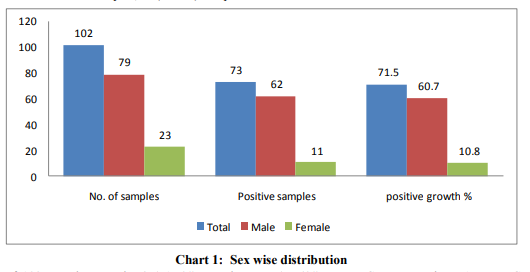
Out of 102 samples tested, 73 (71.5%) samples showed aerobic bacterial growth and 29 (28.5%) samples were sterile. Out of 73 positive samples 20 (27.3%) showed mixed infection and total 94 bacteria were isolated. Out of 94 bacterial isolates, 40 (42.5%) were Gram positive and 54 (57.4%) were Gram negative. Among Gram positive isolates, Staphylococcus aureus 24 (60%) was the most frequently isolated species and E.coli 15 (27.7%) was the most frequently Gram negative isolate.
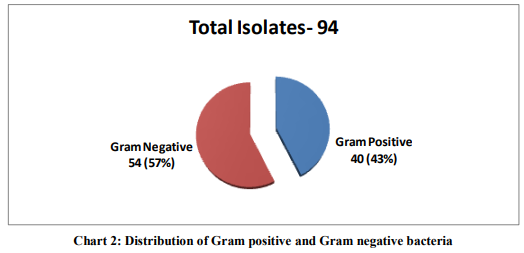
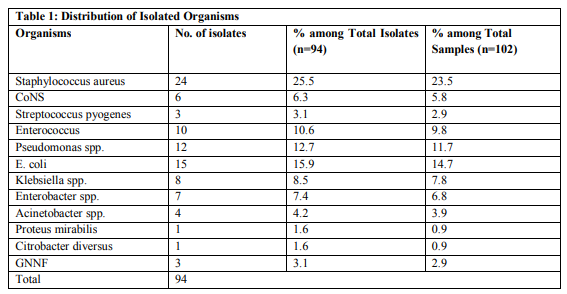
ANTIBIOTIC SENSITIVITY PATTERN
The sensitivity pattern showed that the most effective antibiotic for Gram positive bacteria was Ampicillin + Sulbactam (87.5%) followed by Linezolid (85%) and Levofloxacin (85%). The least effective antibiotic for Gram positive was Ciprofloxacin (52.5%). For Gram negative bacteria, Lomifloxacin (70.3%) followed by Netilline (61.1%) and Gentamicin (61.1%) were the most effective antibiotics and Cefuroxime (18.5%) was the least effective antibiotic. For Staphylococcus aureus, the most effective antibiotic was Ampicillin + Sulbactam (87.5%) and Levofloxacinwas also equally effective whereas least effective antibiotic was Ciprofloxacin (54.1%). For Pseudomonas species, Ceftazidime (91.6%) was most effective antibiotic and least effective was Cefuroxime (25%). For E.coli, the most effective antibiotic was Gentamycin (73.3%) followed by amikacin (66.6%) and Netilline(66.6%). whereas the least effective antibiotic was Pefloxacin (6.6%).
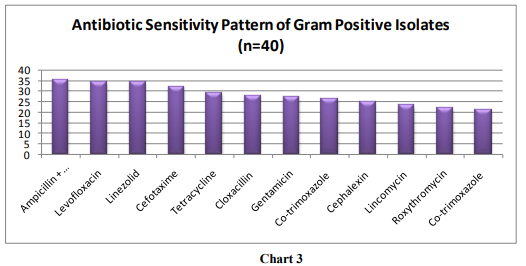
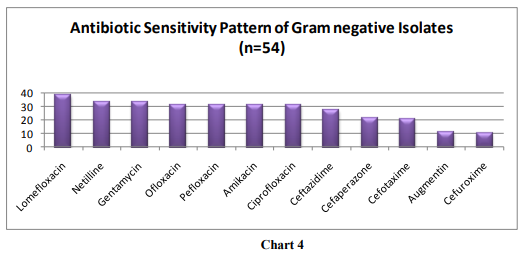
DISCUSSION
In this study, total 102 patients, suffering from post operative infections, were included. Out of which 79 (77.4%) were male and 23 (22.6%) were female. The incidence of post operative infection was more common in males than in females. A study carried out in three hospitals (Federal Medical Centre, Owerri, Imo State University Teaching Hospital, Orlu and General Hospital, Okigwe) by Ohalete et al also supported the result who reported that the males (59.3%) were more prone to wound infection than females (40.7%) [10]. Most commonly isolated organism was Staphylococcus aureus 24 (25.5%) followed by E.coli 15 (15.9%) and Pseudomonas species 12 (12.7%). A similar study conducted in Tertiary Hospital in Benin City, Nigeria by Christopher Aye Egbe et al supported the result, as Staphylococcus aureus was the most commonly isolated bacteria [11]. Another similar study carried out in Nigeria by Akinjogunla, O. J. et al showed that most commonly isolated bacteria was Staphylococcus aureus (37.8%) followed by Pseudomonas species (27%) and E.coli (14.9%) [12]. Aizza Zafar et al and Diane M. Citron et al also supported the result [13, 14]. In vitro sensitivity testing of this study showed that Ampicillin + Sulbactam (87.5%) was the most effective antibiotic against Gram positive bacteria followed by Linezolid (85%). For Gram negative bacteria, Lomifloxacin (70.3%) followed by Netilline (61.1%) were the most effective antibiotics. Ciprofloxacin (52.5%) was the least effective antibiotic for Gram positive bacteria whereas Cefuroxime (18.5%) was the least effective antibiotic for Gram negative bacteria. This data was reinforced by study conducted by Arumugam Suresh et al who reported that Linazolid was the most effective drug agains Gram positive bacteria. A similar study conducted in Trivandrum, india by Asha Konipparambil Pappu et al, who also support the data [15]. Sivaraman Umadevi et al reported only 50% sensitivity of Ciprofloxacin [16]. For Staphylococcus aureus, the most effective antibiotics were Ampicillin + Sulbactam and Levofloxacin (87.5%) whereas least effective antibiotic was Ciprofloxacin (54.1%). For E.coli, the most effective antibiotic was Gentamycin (73.3%) followed by Amikacin (66.6%) and Netilline (66.6%) whereas the least effective antibiotic was Pefloxacin (6.6%). Pseudomonas aeruginosa was highly sensitive to Ciprofloxacin and Netilline (83.3%). This result was reinforced by V.Rajalakshmi et al [17].
CONCLUSION
The most common isolate in post operative infection was Staphylococcus aureus followed by, E.coli, Pseudomonas species, Enterococcus species, Klebsiella species, Enterobacter species and others. Ampicillin / Sulbactum (AS) and Linezolid (LZ) were the most effective antibiotics for Gram positive bacteria and Lomifloxacin followed by Netilline and Gentamicin were the most effective antibiotics for Gram negative bacteria.
References:
1. Shittu A.O., Kolawole d. O., Oyedepo E.A.R, et al. A study of wound infections in two health institutions in ILE-IFE, NIGERIA. Afr. J. Biomed. Res. 2002; 5: 97- 102.
2. Matthew S. Dryden. Complicated skin and soft tissue infection. J Antimicrob Chemother. 2010; 65 Suppl 3: 35-44.
3. Shrestha B, Basnet R.B. Wound infection and antibiotic sensitivity pattern of bacterial isolates. PMJN. 2009 Jan-Jun; 9.
4. Bowler P.G., Duerden B. I., Armstrong D. G. Wound microbiology and associated approaches to wound management. CMR.2001; 14(2):244-269.
5. Mahy B. W, Meulen T, editors. Topley and Wilson’s Microbiology and Microbial Infection. 10th ed. Bacteriology. London: Hodder Arnold; 2007.
6. Suchitra Joyce B, Lakshmidevi N. Surgical site infection. Assessing risk factors, outcomes and antimicrobial sensitivity patterns. African Journal of Microbiology Research. 2009 April; 3(4): 175-179.
7. Cheesbrough M. District Laboratory Practice in Tropical Countries. 2nd ed. New York: Camridge University Press; 2006.
8. Washington C, Allen S. Koneman’s color atlas and textbook of Diagnostic Microbiology. 6th ed. Philadelphia: Lippincott Williams and Wilkins; 2006.
9. Performance Standards for Antimicrobial Disk Susceptibility Tests; Approved Standard-Ninth Edition. CLSI. M2-A9; 26: 1.
10. Ohalete, C.N. Bacteriology of different wound infections and their antimicrobial susceptibility pattern in IMO state Nigeria. World Journal of Pharmacy and Pharmaceutical Sciences. 2012; 1(3): 1155- 1172.
11. Egbe C. A. Microbiology of wound infections and its associated risk fectors among patients of tertiary hospital in Benin City Nigeria. JRHS 2011; 11(2): 109-113.
12. Akinjogunla, O. J. Bacteriology of automobile accident wound infection. International Journal of Medicine and Medical Sciences. 2009; 1 (2): 23-27.
13. Aizza Zafar, Naeem Anwar and Hasan Ejaz. Bacteriology of infected wounds – A study conducted at children’s hospital Lahore. Biomedica. 2008 Jan-Jun; 24: 71-74.
14. Diane M. Citron. Bacteriology of moderate to severe Diabetic foot infections and in vitro activity of antimicrobial agents. J. Clin. Microbiol. 2007; 45(9):2819.
15. Pappu A. K. Microbiological profile of Diabetic Foot Ulcer. Calicut Medical Journal 2011; 9(3):e2.
16. Umadevi S. Microbiological study of diabetic foot infections. Indian Journal of Medical Specialities. 2011; 2(1):12-1
17. Rajalakshmi V. Antibiotic Susceptibility of Bacterial Pathogens Isolated from Diabetic Patients. International Journal of Microbiological Research. 2011; 2(3): 273- 275.
|






 This work is licensed under a Creative Commons Attribution-NonCommercial 4.0 International License
This work is licensed under a Creative Commons Attribution-NonCommercial 4.0 International License